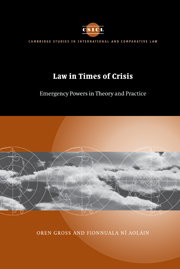Book contents
- Frontmatter
- Contents
- Acknowledgments
- Table of cases
- Table of treaties
- Table of legislation
- Table of international materials
- Introduction
- Part I
- Part II
- 5 International human rights and emergencies
- 6 Emergencies and humanitarian law
- 7 Terrorism, emergencies, and international responses to contemporary threats
- Bibliography
- Index
- CAMBRIDGE STUDIES IN INTERNATIONAL AND COMPARATIVE LAW
7 - Terrorism, emergencies, and international responses to contemporary threats
Published online by Cambridge University Press: 03 September 2009
- Frontmatter
- Contents
- Acknowledgments
- Table of cases
- Table of treaties
- Table of legislation
- Table of international materials
- Introduction
- Part I
- Part II
- 5 International human rights and emergencies
- 6 Emergencies and humanitarian law
- 7 Terrorism, emergencies, and international responses to contemporary threats
- Bibliography
- Index
- CAMBRIDGE STUDIES IN INTERNATIONAL AND COMPARATIVE LAW
Summary
One fundamental issue encountered by the subject matter of this book and thrown into sharp relief by contemporary events is whether the phenomenon of terrorism creates the material conditions that activate the conceptual and regulatory space of “emergency” or whether terrorism constitutes a fundamentally distinct phenomenon that cannot be captured by the emergency framework (either domestic or international). A follow-on and obvious question is whether terror attacks in a given society can legitimately create a state of emergency. This chapter seeks to explore that terrain by mapping out the features and, where appropriate, the distinctiveness of terrorism. The analysis then seeks to assess how terrorism (in its various guises) fits into the models proposed in Part I of this book. Following from this, the chapter undertakes an analysis of the applicable legal regimes relevant to terrorism. We conclude with an examination of how the events of September 11, 2001 have shaped national and international legal responses to terrorism and how these responses “fit” or not into the general framework of emergency powers.
We start with the caveat that any serious discussion of terrorism as a phenomenon is fraught as both an intellectual and policy enterprise. The current political climate, in which sweeping categorizations about the nature and form of all types of violence directed against states are rife, discourages any attempts to disaggregate the phenomenon of terrorism from other forms of violence.
- Type
- Chapter
- Information
- Law in Times of CrisisEmergency Powers in Theory and Practice, pp. 365 - 421Publisher: Cambridge University PressPrint publication year: 2006



